|
|
Post by pieter on Dec 10, 2021 16:17:39 GMT -7
Interesting documentary about Ukrainian officers and solidiers fighting in the Donetsk region in Eastern Ukraine. Many of them died fighting for their fatherland. Patch of the 93rd Mechanized BrigadeThe 93rd Mechanized Brigade is a formation of the Ukrainian Ground Forces. The full name of the Brigade is the 93rd Independent Kholodnyi Yar Mechanized Brigade. HistoryThe Brigade traces its history back to the 93rd Guards Rifle Division of the Soviet Union's Red Army, formed at Valuki in April 1943 from 13th Guards and 92nd Rifle Brigades. The division fought at Kursk, Kharkiv, Budapest, and Prague, and was serving with the 53rd Army of the 2nd Ukrainian Front in May 1945. After a period as a 35th Guards Mechanized Division, and then 35th Guards Motor Rifle Division 1957-65, the division was redesignated as the 93rd Guards Motor Rifle Division in 1965. It served with the Southern Group of Forces in Hungary during the last years of the Cold War, and after the fall of the Berlin Wall was withdrawn to Ukraine from October 1990 to January 1991. Patch of the 93rd Mechanized BrigadeThe 93rd Mechanized Brigade is a formation of the Ukrainian Ground Forces. The full name of the Brigade is the 93rd Independent Kholodnyi Yar Mechanized Brigade. HistoryThe Brigade traces its history back to the 93rd Guards Rifle Division of the Soviet Union's Red Army, formed at Valuki in April 1943 from 13th Guards and 92nd Rifle Brigades. The division fought at Kursk, Kharkiv, Budapest, and Prague, and was serving with the 53rd Army of the 2nd Ukrainian Front in May 1945. After a period as a 35th Guards Mechanized Division, and then 35th Guards Motor Rifle Division 1957-65, the division was redesignated as the 93rd Guards Motor Rifle Division in 1965. It served with the Southern Group of Forces in Hungary during the last years of the Cold War, and after the fall of the Berlin Wall was withdrawn to Ukraine from October 1990 to January 1991.
There it became part of the Ukrainian Armed Forces. In Decree 925/96, Colonel Anatoly Savatiovich Pushnyakov, Commander of the 93rd Mechanised Division of the 6th Army Corps, Southern Operational Command, Ukrainian Ground Forces, was promoted to General-Major.
The division appears to have been redesignated a brigade after 1996 and after 1999.
Throughout 1999, the '93rd Motor Rifle Division' conducted a series of small unit and staff officer exchanges with the 40th Infantry Division of the California Army National Guard.
On December 10, 2007 the Brigade received its Colour by the order of the President of Ukraine.
The brigade fought in the war in Donbas, defending Donetsk International Airport during the Second Battle of Donetsk Airport alongside the 95th Airmobile Brigade.
The brigade is currently based in Krasnoarmiisk. On 18 November 2015 its honorifics "Twice Red Banner Orders of Suvorov and Kutuzov" were removed as part of an Armed Forces-wide removal of Soviet awards and honorifics, but not its Kharkiv battle honor, given as a result of its participation in the 1943 Belgorod-Khar'kov Offensive Operation. On 22 August 2016, its Guards title was also removed.
In honor of the centennial year of the Ukrainian War of Independence the brigade received its second honorific title, Kholodnyi Yar (Kholodnyi Yar was a pro-Ukrainian partisan self-proclaimed state that existed from 1919 to 1922), in 2018, and thus its Kharkiv battle honour was officially removed from the full title of the unit. A new colour was also received by the brigade command which differs from the maroon colour it received in 2007. Participation in peacekeeping missions Ukrainian army in IraqIn the recent history of the Armed Forces of Ukraine, the 93rd Division became the first basic unit to train the first units of the peacekeeping forces. The 108th peacekeeping training center was established on the basis of the 112th Motorized Rifle Regiment of the division. Here were formed 15 rotations of the 240th battalion, which performed peacekeeping functions in the former Yugoslavia. Also on the basis of the 3rd Mechanized Battalion, the 71st Separate Mechanized Battalion was formed to be included in the 7th Separate Mechanized Brigade, which carried out the peacekeeping mission in Iraq in 2004-2005, but was disbanded at the end of training due to the decision to reduce the contingent, a small part of its personnel was sent to replenish the 73rd Battalion. Soldiers also served in peacekeeping operations in Sierra Leone, Liberia, and Lebanon. The Donbas war Ukrainian army in IraqIn the recent history of the Armed Forces of Ukraine, the 93rd Division became the first basic unit to train the first units of the peacekeeping forces. The 108th peacekeeping training center was established on the basis of the 112th Motorized Rifle Regiment of the division. Here were formed 15 rotations of the 240th battalion, which performed peacekeeping functions in the former Yugoslavia. Also on the basis of the 3rd Mechanized Battalion, the 71st Separate Mechanized Battalion was formed to be included in the 7th Separate Mechanized Brigade, which carried out the peacekeeping mission in Iraq in 2004-2005, but was disbanded at the end of training due to the decision to reduce the contingent, a small part of its personnel was sent to replenish the 73rd Battalion. Soldiers also served in peacekeeping operations in Sierra Leone, Liberia, and Lebanon. The Donbas war Members of the Ukrainian army’s 93rd Mechanized Brigade on operations in February 2021The brigade was deployed in the war in Donbas against the Russian army and its proxy forces. The unit fought on the frontlines from 2014-2016 before being recalled in March 2016. During this period, 138 soldiers were killed in action, over 1,000 were wounded, and 9 soldiers were held as prisoners of war. The brigade was involved in the battle of Ilovaisk, Avdiivka, the defence of Donetsk airport, the defence of Marinka, and the defence of Pisky. A documentary 93: Battle for Ukraine has been made by Ukrainian director Lidia Guzhva (See video's above here) about the brigade's role in the war, constructed primarily from videos made by members of the brigade themselves, as well as interviews with members of the brigade. Members of the Ukrainian army’s 93rd Mechanized Brigade on operations in February 2021The brigade was deployed in the war in Donbas against the Russian army and its proxy forces. The unit fought on the frontlines from 2014-2016 before being recalled in March 2016. During this period, 138 soldiers were killed in action, over 1,000 were wounded, and 9 soldiers were held as prisoners of war. The brigade was involved in the battle of Ilovaisk, Avdiivka, the defence of Donetsk airport, the defence of Marinka, and the defence of Pisky. A documentary 93: Battle for Ukraine has been made by Ukrainian director Lidia Guzhva (See video's above here) about the brigade's role in the war, constructed primarily from videos made by members of the brigade themselves, as well as interviews with members of the brigade.
The brigade returned to the frontline. On 19 July 2016 an IFV of the brigade detonated an IED, killing two soldiers.
In June 2017 the brigade moved deeper into the no man's land near the village of Krymske and set up fortifications there "to exert stricter fire control over the enemy, and provides for a better defense."
|
|
|
|
Post by pieter on Dec 10, 2021 16:56:47 GMT -7
|
|
|
|
Post by karl on Dec 11, 2021 10:18:21 GMT -7
Pieter
An excellent example of first hand reporting of a combat situation as with the Ukrainian 93rd Mechanized Brigade. War is not comforting, but when exicuted correctly with the courage of fighting for their own country against an invader is right.
I do say this with tongue in cheek.
Karl
|
|
|
|
Post by Jaga on Dec 12, 2021 6:41:46 GMT -7
we don't want this war, lets hope that both parties would stay cool. Biden decided not to send ore troops now, to not accelerate the tension anymore
|
|
|
|
Post by pieter on Dec 13, 2021 19:09:24 GMT -7
we don't want this war, lets hope that both parties would stay cool. Biden decided not to send ore troops now, to not accelerate the tension anymore Jaga, Unfortunately the Ukrainian government army and Ukrainian paramilitaire militia like the Azov batallion on one side and the the United Armed Forces of Novorossiya of the the Donetsk People's Republic and Luhansk People's Republic, and next to these the Russian militia and members of the Russian army in Eastern Ukraine on the other side are at war with each other. Cheers, Pieter |
|
|
|
Post by Jaga on Dec 14, 2021 4:48:38 GMT -7
Pieter,
therefore we need to be careful to provide extra weapons for any side. I am not surprised Angela Merkel did not want to participate in giving Ukraine more military equipment.
|
|
|
|
Post by pieter on Dec 14, 2021 6:43:22 GMT -7
The Donbas war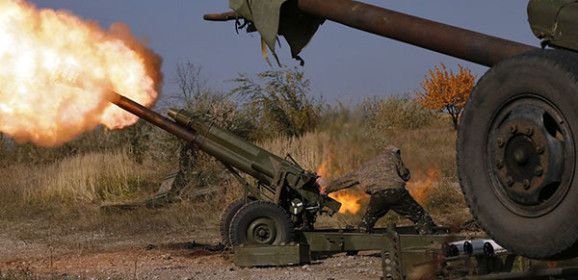 The Ukrainian military journalist and blogger Yuriy Butusov claimed in 2017 that Russian artillery systems used against the Ukrainian army in Donbas have begun shelling at longer distances.The Donbas War is already taking place for 8 years now. 6 April 2014 – present (7 years, 8 months, 1 week and 1 day) to be exactly. Villages, Hamlets, Uraban Agglomerations and towns, cities and Industrial area’s, the Donetsk Sergei Prokofiev International Airport, schools, hospitals, residential area’s, farms, apartment buildings, flats and houses of civilians (both Ukrainian and Russians) were destroyed and many people died due to the shelling, artillery fire, mortar fire, being killed by shrapnel, tank fire, heavy machine gun fire, rocket fire, sniper fire or being killed by militia members. Like most wars this is a vicious war, with deeper underlying historical layers, hatred, fierce emotions, fanatism, nationalism (Ukrainian nationalism on one side and Russian nationalism and imperialism on the other side. The Russian separatists of Eastern-Ukraine merge anti-fascist rhetorics, Sovjet nostalgia and Sovjet Patriotism, Eastern UkrainIan identity (East vs West and Centre), with Russian Patriotism, Russian Nationalism and Russian Orthodox (Christian) identity, some Pan-Slave elements and the concept of Russian-Ukrainian brotherhood vs Ukrainian Fascism, Nazism and Banderism (the ideology of the Ukrainian nationalist followers and admirers of Stepan Bandera (1909 – 15 October 1959) a Ukrainian politician and theorist of the militant wing of the far-right Organization of Ukrainian Nationalists and a leader and ideologist of Ukrainian ultranationalists known for his involvement in terrorist activities.) Today Ukrainian Nationalists, Far right Ukrainian activists and members of the Azov Battalion ( en.wikipedia.org/wiki/Azov_Battalion ),the Ukrainian nationalist political party and paramilitary movement Pravyi sektor (Right Sector; en.wikipedia.org/wiki/Right_Sector ), the Congress of Ukrainian Nationalists ( en.wikipedia.org/wiki/Congress_of_Ukrainian_Nationalists ), and the ultranationalist political Svoboda party are called (labeled as) Banderovits, followers of the late Stepan Bandera (1909 – 1959). The Ukrainian military journalist and blogger Yuriy Butusov claimed in 2017 that Russian artillery systems used against the Ukrainian army in Donbas have begun shelling at longer distances.The Donbas War is already taking place for 8 years now. 6 April 2014 – present (7 years, 8 months, 1 week and 1 day) to be exactly. Villages, Hamlets, Uraban Agglomerations and towns, cities and Industrial area’s, the Donetsk Sergei Prokofiev International Airport, schools, hospitals, residential area’s, farms, apartment buildings, flats and houses of civilians (both Ukrainian and Russians) were destroyed and many people died due to the shelling, artillery fire, mortar fire, being killed by shrapnel, tank fire, heavy machine gun fire, rocket fire, sniper fire or being killed by militia members. Like most wars this is a vicious war, with deeper underlying historical layers, hatred, fierce emotions, fanatism, nationalism (Ukrainian nationalism on one side and Russian nationalism and imperialism on the other side. The Russian separatists of Eastern-Ukraine merge anti-fascist rhetorics, Sovjet nostalgia and Sovjet Patriotism, Eastern UkrainIan identity (East vs West and Centre), with Russian Patriotism, Russian Nationalism and Russian Orthodox (Christian) identity, some Pan-Slave elements and the concept of Russian-Ukrainian brotherhood vs Ukrainian Fascism, Nazism and Banderism (the ideology of the Ukrainian nationalist followers and admirers of Stepan Bandera (1909 – 15 October 1959) a Ukrainian politician and theorist of the militant wing of the far-right Organization of Ukrainian Nationalists and a leader and ideologist of Ukrainian ultranationalists known for his involvement in terrorist activities.) Today Ukrainian Nationalists, Far right Ukrainian activists and members of the Azov Battalion ( en.wikipedia.org/wiki/Azov_Battalion ),the Ukrainian nationalist political party and paramilitary movement Pravyi sektor (Right Sector; en.wikipedia.org/wiki/Right_Sector ), the Congress of Ukrainian Nationalists ( en.wikipedia.org/wiki/Congress_of_Ukrainian_Nationalists ), and the ultranationalist political Svoboda party are called (labeled as) Banderovits, followers of the late Stepan Bandera (1909 – 1959).
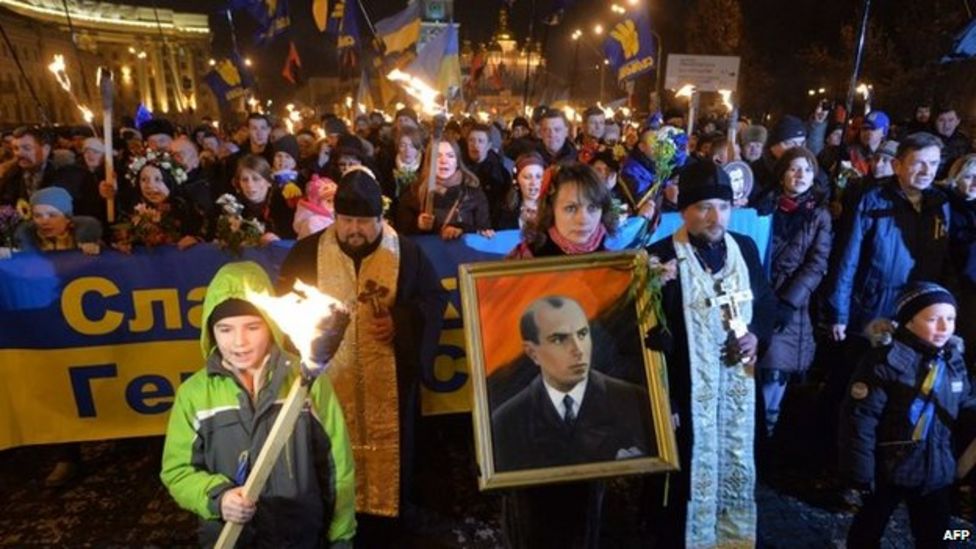
Demonstration of the Svoboda party in Kiev on 1 January 2014. The marchers were commemorating Stepan Bandera's 105th birthday.

Members of the nationalist Svoboda (Freedom) party, the far-right Right Sector and the National Corps party founded by members of the Azov battalion during a Nationalist demonstration In Kiev in Februari 2017. None of the three groups behind the rally represented in the Ukrainian parliament in that time. The were/are the voice of the street and the outerparliamnetary Nationalist opposition. You could call the people in this demonstration Banderovits
Svoboda's political position has been described as right-wing or far-right. Widely described as an ultranationalist and right-wing populist party, it expressed support and staged commemorations honoring Stepan Bandera, and it opposes immigration, globalism and free trade. Stepan Andriyovych Bandera (Ukrainian: Степан Андрійович Бандера, Polish: Stepan Andrijowycz Bandera; 1 January 1909 – 15 October 1959) was a Ukrainian politician and theorist of the militant wing of the far-right Organization of Ukrainian Nationalists and a leader and ideologist of Ukrainian ultranationalists known for his involvement in terrorist activities. Stepan Andriyovych Bandera (Ukrainian: Степан Андрійович Бандера, Polish: Stepan Andrijowycz Bandera; 1 January 1909 – 15 October 1959) was a Ukrainian politician and theorist of the militant wing of the far-right Organization of Ukrainian Nationalists and a leader and ideologist of Ukrainian ultranationalists known for his involvement in terrorist activities. An Ukrainian soldier fires a gun during the Donbas war somewhere in Eastern UkraineFor many Poles the conflict in Eastern-Ukraine and the Donbas War (2014-present) is a difficult one, because they are neither very Pro-Ukrainian nor very Pro-Russian. The Poles suffered both under Stalinism during the Sovjet Occupation, Russian and Ukrainian Nazi collaboration (Ukrainian involvement in oppressing the Warsaw Uprising -the Ukrainian commander of the the 31. Schutzmannschafts-Bataillon der SD, Petro Dyachenko, organized a military unit out of the battalion and he participated in crushing of Polish resistance against Nazis.- , the (Ukrainian) 14th Waffen Grenadier Division of the SS (1st Galician) was involved in actions against Polish partisans in the Zamość area, Ukrainian Kapo’s were one of the most sadist elements in Nazi concentration camps and the UPA (Ukrainian Insurgent Army -1942-1956-)and Organization of Ukrainian Nationalists-B (OUN-B) played a substantial role in the ethnic cleansing of the Polish population of Volhynia and East Galicia. An Ukrainian soldier fires a gun during the Donbas war somewhere in Eastern UkraineFor many Poles the conflict in Eastern-Ukraine and the Donbas War (2014-present) is a difficult one, because they are neither very Pro-Ukrainian nor very Pro-Russian. The Poles suffered both under Stalinism during the Sovjet Occupation, Russian and Ukrainian Nazi collaboration (Ukrainian involvement in oppressing the Warsaw Uprising -the Ukrainian commander of the the 31. Schutzmannschafts-Bataillon der SD, Petro Dyachenko, organized a military unit out of the battalion and he participated in crushing of Polish resistance against Nazis.- , the (Ukrainian) 14th Waffen Grenadier Division of the SS (1st Galician) was involved in actions against Polish partisans in the Zamość area, Ukrainian Kapo’s were one of the most sadist elements in Nazi concentration camps and the UPA (Ukrainian Insurgent Army -1942-1956-)and Organization of Ukrainian Nationalists-B (OUN-B) played a substantial role in the ethnic cleansing of the Polish population of Volhynia and East Galicia. The Ukrainian commander of the the 31. Schutzmannschafts-Bataillon der SD, Petro Dyachenko The Ukrainian commander of the the 31. Schutzmannschafts-Bataillon der SD, Petro Dyachenko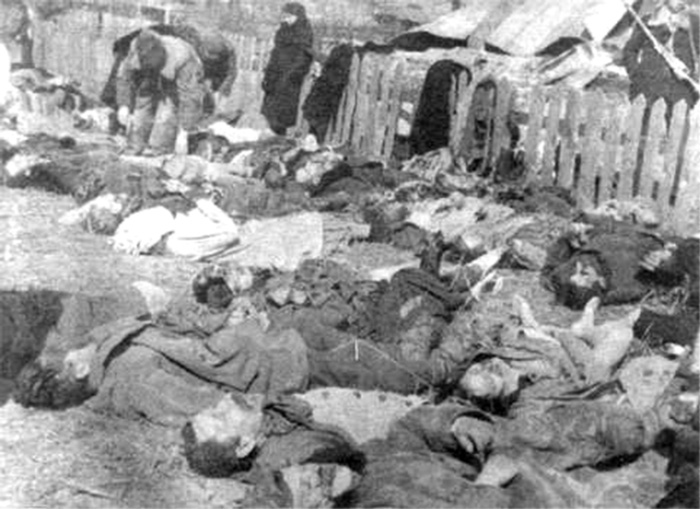 The ethnic cleansing of the Polish population of Volhynia and East Galicia neweasterneurope.eu/2018/07/11/memory-volhynia-still-divides-recent-polish-survey-leaves-no-doubts/In the middle of the night on July 11, 1943, the Ukrainian Insurgent Army unexpectedly attacked some 150 Polish villages, brutally massacring everyone—regardless of age or gender, including newborn babies—who were not ethnically Ukrainian—Poles, Jews, Armenians, Czechs and others. The ethnic cleansing of the Polish population of Volhynia and East Galicia neweasterneurope.eu/2018/07/11/memory-volhynia-still-divides-recent-polish-survey-leaves-no-doubts/In the middle of the night on July 11, 1943, the Ukrainian Insurgent Army unexpectedly attacked some 150 Polish villages, brutally massacring everyone—regardless of age or gender, including newborn babies—who were not ethnically Ukrainian—Poles, Jews, Armenians, Czechs and others.
The massacres of Poles in Volhynia and Eastern Galicia, were carried out in German-occupied Poland by the Ukrainian Insurgent Army (UPA). The mass murder of the Poles with the support of parts of the local Ukrainian population against the Polish minority in Volhynia, Eastern Galicia, parts of Polesia and the Lublin region from 1943 to 1945. The peak of the massacres took place in July and August 1943. Most of the victims were women and children. Many of the Polish victims regardless of age or gender were tortured before being killed; some of the methods included rape, dismemberment or immolation, among others. The UPA's actions resulted in between 50,000 and 100,000 deaths.

The massacres of Poles in Volhynia and Eastern Galicia, were carried out in German-occupied Poland by the Ukrainian Insurgent Army (UPA).
Ad to that the Polish–Ukrainian War (1 November 1918 – 18 July 1919 (8 months, 2 weeks and 3 days) with 25 thousand people killed on both sides and the history of the Polish-Lithuanian Commonwealth, the Anti-Polish (Catholic) and anti-Polish Jewish sentiments amongst the Ukrainian farmers of that time and the bloody Khmelnytsky Uprising (Polish: powstanie Chmielnickiego) of 1648–1657, which costed the lives of many Roman-Catholic Poles and Polish Jews in massacres. This history Poles didn’t forgot and therefor Poles know that Ukrainian Ultra nationalism is often both anti-Russian and anti-Polish. And often also fiercely antisemitic. There are even Polish mercenaries fighting on the Russian Seperatist side in Eastern Ukraine. Of Course Polish Ukrainians from Lviv fight in the Ukrainian army at the same time.
“Many Poles are really fighting on the side of Kiev in this conflict. They go there and join the volunteer battalions as private individuals, but the official Polish authorities will never confirm this to you, although they secretly help recruiters, ”said Bartosz Becker, head of the Polish far-right organization Phalanga in Februari 2015.  A group of Polish Volunteers arrived to Donetsk to participate in the defense of Donbass. Polish troops led by a student of political science Bartosz Becker. A group of Polish Volunteers arrived to Donetsk to participate in the defense of Donbass. Polish troops led by a student of political science Bartosz Becker.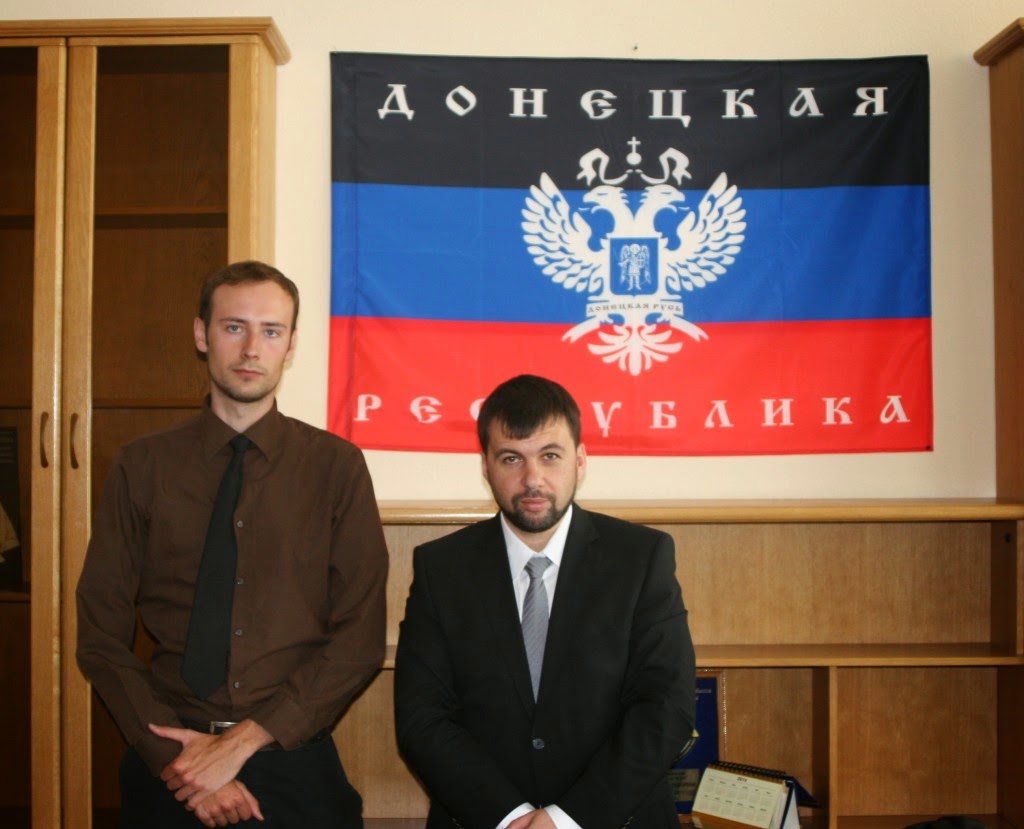 Bartosz Becker, head of the Polish far-right organization Phalanga and Denis Pushilin Chairman of Donetsk People's Republic (DPR) Bartosz Becker, head of the Polish far-right organization Phalanga and Denis Pushilin Chairman of Donetsk People's Republic (DPR)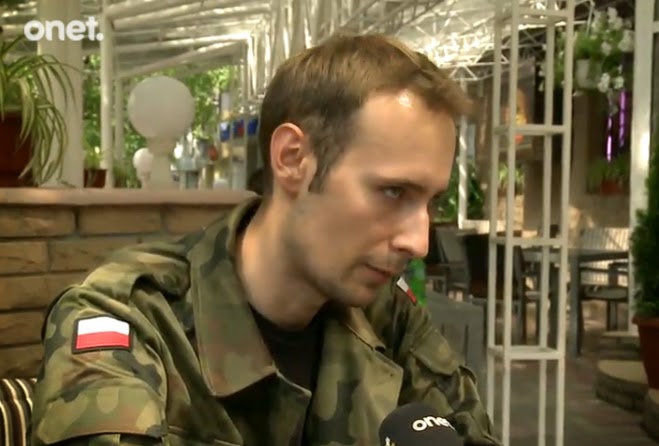 It is estimated that more than 17,000 foreign fighters joined one of the armed parties in the conflict in Ukraine. That number is considerable, although it should be noted that the majority of these fighters – some 15,000 – came from Russia. The remaining group consists largely of 1,800 Europeans, of whom about a third joined the pro-Ukrainian groups, while the remaining two-thirds went to the separatists. According to the Soufan Center, this influx of foreign fighters should be seen in the context of the transnational rise of right-wing extremism (or white supremacy extremism, as the Soufan Center prefers to call it). This claim corresponds to a wider trend in the academic debate, with scholars increasingly shifting their attention away from jihadism towards such an alleged extreme-right wing wave of terrorism. The concern of the Soufan Center is that similar to how Afghanistan became a rallying point for jihadist groups in the 1980s, Ukraine has now become one for right-wing extremists, who are being hardened there both ideologically and militarily. As MacKenzie and Kaunert recently noted, such claims of the country being a “battlefield laboratory” are gaining prominence. Therefore, it seems high time to get a better.Pro-Russian activists in Eastern Ukraine (Donbas region) claimed: "Those people in Kyiv are Bandera-following Nazi collaborators."Eastern Ukraine: Battleground for civilian militias and international volunteers It is estimated that more than 17,000 foreign fighters joined one of the armed parties in the conflict in Ukraine. That number is considerable, although it should be noted that the majority of these fighters – some 15,000 – came from Russia. The remaining group consists largely of 1,800 Europeans, of whom about a third joined the pro-Ukrainian groups, while the remaining two-thirds went to the separatists. According to the Soufan Center, this influx of foreign fighters should be seen in the context of the transnational rise of right-wing extremism (or white supremacy extremism, as the Soufan Center prefers to call it). This claim corresponds to a wider trend in the academic debate, with scholars increasingly shifting their attention away from jihadism towards such an alleged extreme-right wing wave of terrorism. The concern of the Soufan Center is that similar to how Afghanistan became a rallying point for jihadist groups in the 1980s, Ukraine has now become one for right-wing extremists, who are being hardened there both ideologically and militarily. As MacKenzie and Kaunert recently noted, such claims of the country being a “battlefield laboratory” are gaining prominence. Therefore, it seems high time to get a better.Pro-Russian activists in Eastern Ukraine (Donbas region) claimed: "Those people in Kyiv are Bandera-following Nazi collaborators."Eastern Ukraine: Battleground for civilian militias and international volunteers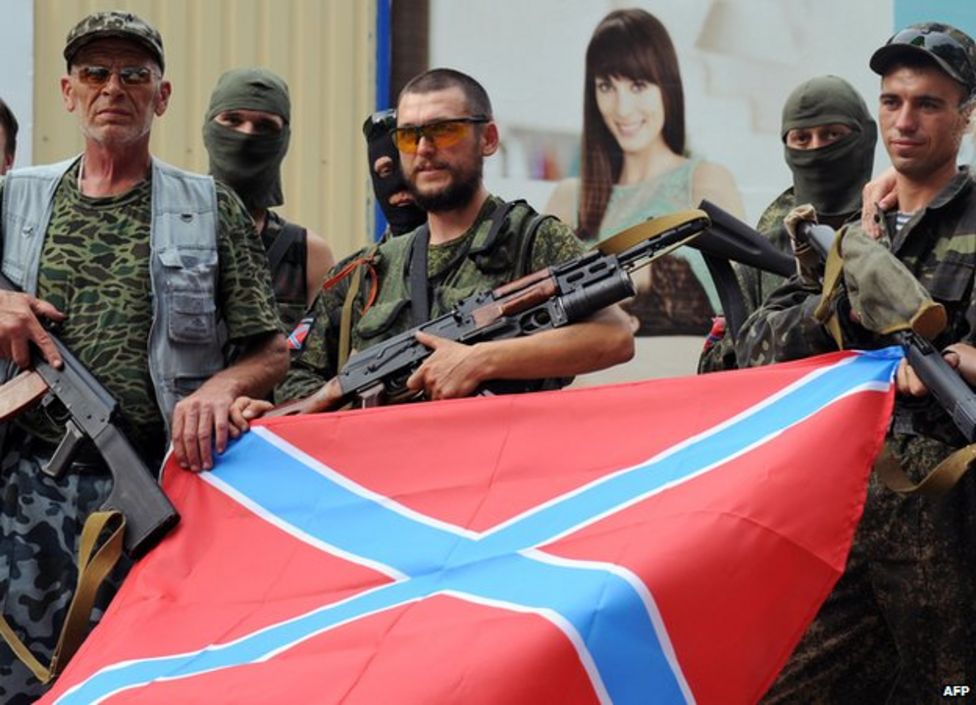 Separatist (Pro-Russian) militants in Donetsk sport the tsarist-era "Novorossiya" flagThe war in Ukraine is the product of a complex combination of factors – including social, economic and historical– but above all, it seems to be about the country’s attitude towards the European Union and Russia. The suspension of negotiations on the forthcoming association agreement with the EU led to the mass pro-European street protests in November 2013. The violent escalation of these protests, which would eventually drive then-President Yanukovych out of the capital, resulted in military intervention by Russia: it annexed Crimea, claiming to protect the ethnic Russians there, and covertly supported armed pro-Russian separatists in eastern Ukraine. Separatist (Pro-Russian) militants in Donetsk sport the tsarist-era "Novorossiya" flagThe war in Ukraine is the product of a complex combination of factors – including social, economic and historical– but above all, it seems to be about the country’s attitude towards the European Union and Russia. The suspension of negotiations on the forthcoming association agreement with the EU led to the mass pro-European street protests in November 2013. The violent escalation of these protests, which would eventually drive then-President Yanukovych out of the capital, resulted in military intervention by Russia: it annexed Crimea, claiming to protect the ethnic Russians there, and covertly supported armed pro-Russian separatists in eastern Ukraine.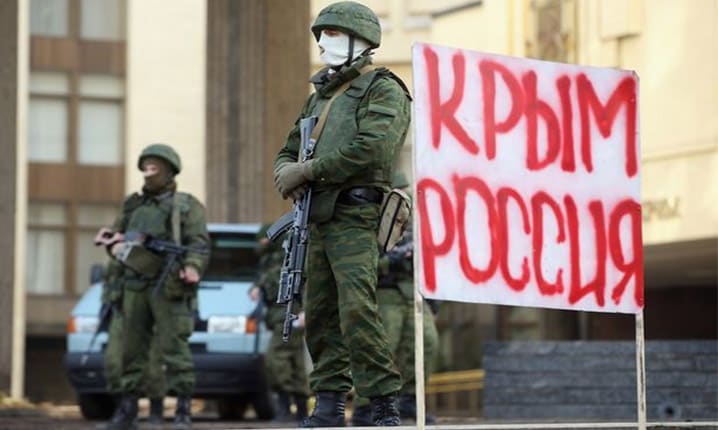 Annexed Crimea. Unidentified soldiers – 'little green men' – guard the Crimean parliament building next to a sign that reads 'Crimea Russia' (2 March 2014)Confronted with this separatist movement, Petro Poroshenko’s new government faced a problem – after decades of corruption and neglect, the Ukrainian army’s facilities and the morale of its troops were diminished. Poroshenko therefore decided to join forces with dozens of spontaneously-created volunteer militias. While these played an important role in stopping the pro-Russian advance, it became a major challenge for the government to control these groups, some of which started to commit war crimes. Whereas most battalions were later disbanded or incorporated into the Ukrainian army, some retained a degree of autonomy, often accompanied by extremist thinking. Two notorious examples are the Azov and Pravy Sektor (or ‘Right Sector’) battalions. Already in the autumn of 2014, The Guardian reported that a large group of Azov members would adhere to far-right or neo-Nazi ideas. They glorified Adolf Hitler’s leadership, denied the Holocaust, and the battalion symbol showed the sonnenrad – a common symbol among neo-Nazis. Annexed Crimea. Unidentified soldiers – 'little green men' – guard the Crimean parliament building next to a sign that reads 'Crimea Russia' (2 March 2014)Confronted with this separatist movement, Petro Poroshenko’s new government faced a problem – after decades of corruption and neglect, the Ukrainian army’s facilities and the morale of its troops were diminished. Poroshenko therefore decided to join forces with dozens of spontaneously-created volunteer militias. While these played an important role in stopping the pro-Russian advance, it became a major challenge for the government to control these groups, some of which started to commit war crimes. Whereas most battalions were later disbanded or incorporated into the Ukrainian army, some retained a degree of autonomy, often accompanied by extremist thinking. Two notorious examples are the Azov and Pravy Sektor (or ‘Right Sector’) battalions. Already in the autumn of 2014, The Guardian reported that a large group of Azov members would adhere to far-right or neo-Nazi ideas. They glorified Adolf Hitler’s leadership, denied the Holocaust, and the battalion symbol showed the sonnenrad – a common symbol among neo-Nazis.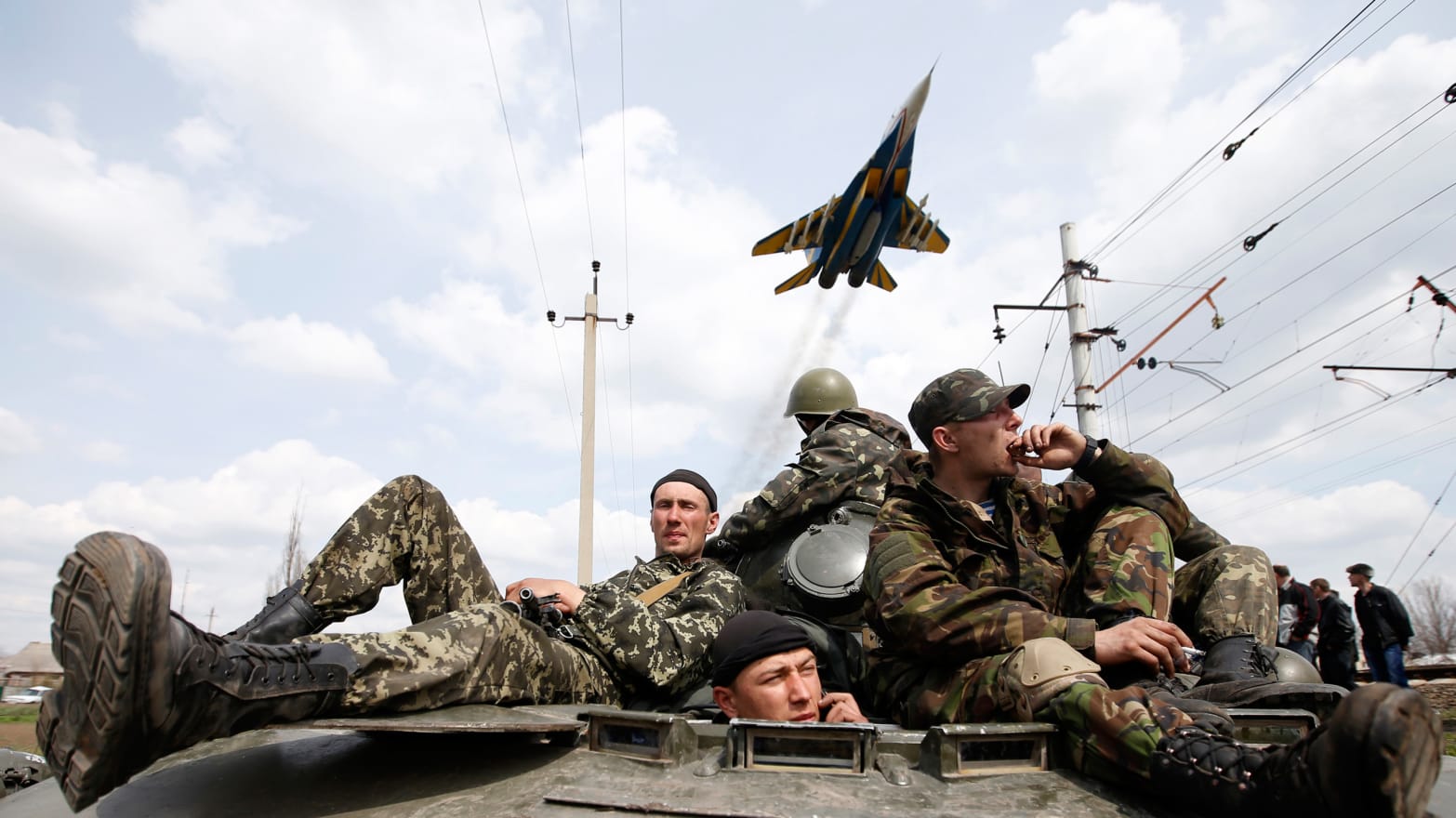 The Ukrainian army in 2014Pravy Sektor is also often described as ultra-right-wing or ultranationalist. Although Russian propaganda has been very effective in enlarging the fascist characteristics of these groups, it is clear that they adhere to ideologies at odds with liberalism and multiculturalism, and that group members generally distrust the “corrupt” politicians in Kiev. Interestingly, this contributes to the fact that the ideological differences between pro-Ukrainian fighters and their opponents on the pro-Russian side are sometimes very small. The Ukrainian army in 2014Pravy Sektor is also often described as ultra-right-wing or ultranationalist. Although Russian propaganda has been very effective in enlarging the fascist characteristics of these groups, it is clear that they adhere to ideologies at odds with liberalism and multiculturalism, and that group members generally distrust the “corrupt” politicians in Kiev. Interestingly, this contributes to the fact that the ideological differences between pro-Ukrainian fighters and their opponents on the pro-Russian side are sometimes very small. Members of the Pravy Sektor in Kiev. Members of the Pravy Sektor in Kiev.Source: icct.nl/publication/the-forgotten-front-dutch-fighters-in-ukraine/In 2014, pro-Russian protests took place in parts of eastern Ukraine. Some of the protesters were "tourists" from Russia. The war in Donbas resulted in thousands of deaths and over a million people leaving their homes. As of 2016, about half of the territory of Donbas is controlled by the self-proclaimed Donetsk People's Republic and Luhansk People's Republic.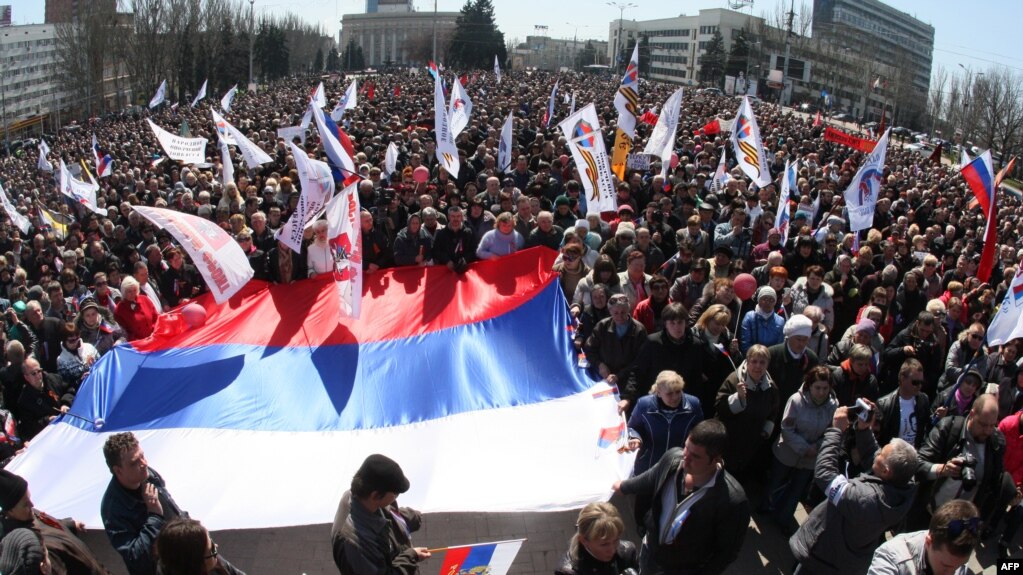 In 2014, pro-Russian protests took place in parts of eastern UkraineThe war In 2014, pro-Russian protests took place in parts of eastern UkraineThe war Pro-Kyiv troops in clahes with Donbas Russian seperatist troups and Russian armed forcesThe war in Donbas, or the Donbas war, is an armed conflict in the Donbas region of Ukraine, part of the Ukrainian crisis and the broader Russo-Ukrainian War. From the beginning of March 2014, in the aftermath of the 2014 Ukrainian revolution and the Euromaidan movement, protests by Russia-backed anti-government separatist groups took place in the Donetsk and Luhansk oblasts of Ukraine, collectively called the Donbas region. These demonstrations, which followed the February–March 2014 annexation of Crimea by the Russian Federation, and which were part of a wider group of concurrent protests across southern and eastern Ukraine, escalated into an armed conflict between the separatist forces of the self-declared Donetsk and Luhansk People's Republics (DPR and LPR respectively), and the Ukrainian government.While the initial protests were largely native expressions of discontent with the new Ukrainian government, Russia took advantage of them to launch a co-ordinated political and military campaign against Ukraine. Russian citizens led the separatist movement in Donetsk from April until August 2014, and were supported by volunteers and materiel from Russia. As the conflict escalated in May 2014, Russia employed a "hybrid approach", deploying a combination of disinformation tactics, irregular fighters, regular Russian troops, and conventional military support to destabilise the Donbas region. According to the Ukrainian government, at the height of the conflict in the summer of 2014, Russian paramilitaries were reported to make up between 15% to 80% of the combatants. Pro-Kyiv troops in clahes with Donbas Russian seperatist troups and Russian armed forcesThe war in Donbas, or the Donbas war, is an armed conflict in the Donbas region of Ukraine, part of the Ukrainian crisis and the broader Russo-Ukrainian War. From the beginning of March 2014, in the aftermath of the 2014 Ukrainian revolution and the Euromaidan movement, protests by Russia-backed anti-government separatist groups took place in the Donetsk and Luhansk oblasts of Ukraine, collectively called the Donbas region. These demonstrations, which followed the February–March 2014 annexation of Crimea by the Russian Federation, and which were part of a wider group of concurrent protests across southern and eastern Ukraine, escalated into an armed conflict between the separatist forces of the self-declared Donetsk and Luhansk People's Republics (DPR and LPR respectively), and the Ukrainian government.While the initial protests were largely native expressions of discontent with the new Ukrainian government, Russia took advantage of them to launch a co-ordinated political and military campaign against Ukraine. Russian citizens led the separatist movement in Donetsk from April until August 2014, and were supported by volunteers and materiel from Russia. As the conflict escalated in May 2014, Russia employed a "hybrid approach", deploying a combination of disinformation tactics, irregular fighters, regular Russian troops, and conventional military support to destabilise the Donbas region. According to the Ukrainian government, at the height of the conflict in the summer of 2014, Russian paramilitaries were reported to make up between 15% to 80% of the combatants.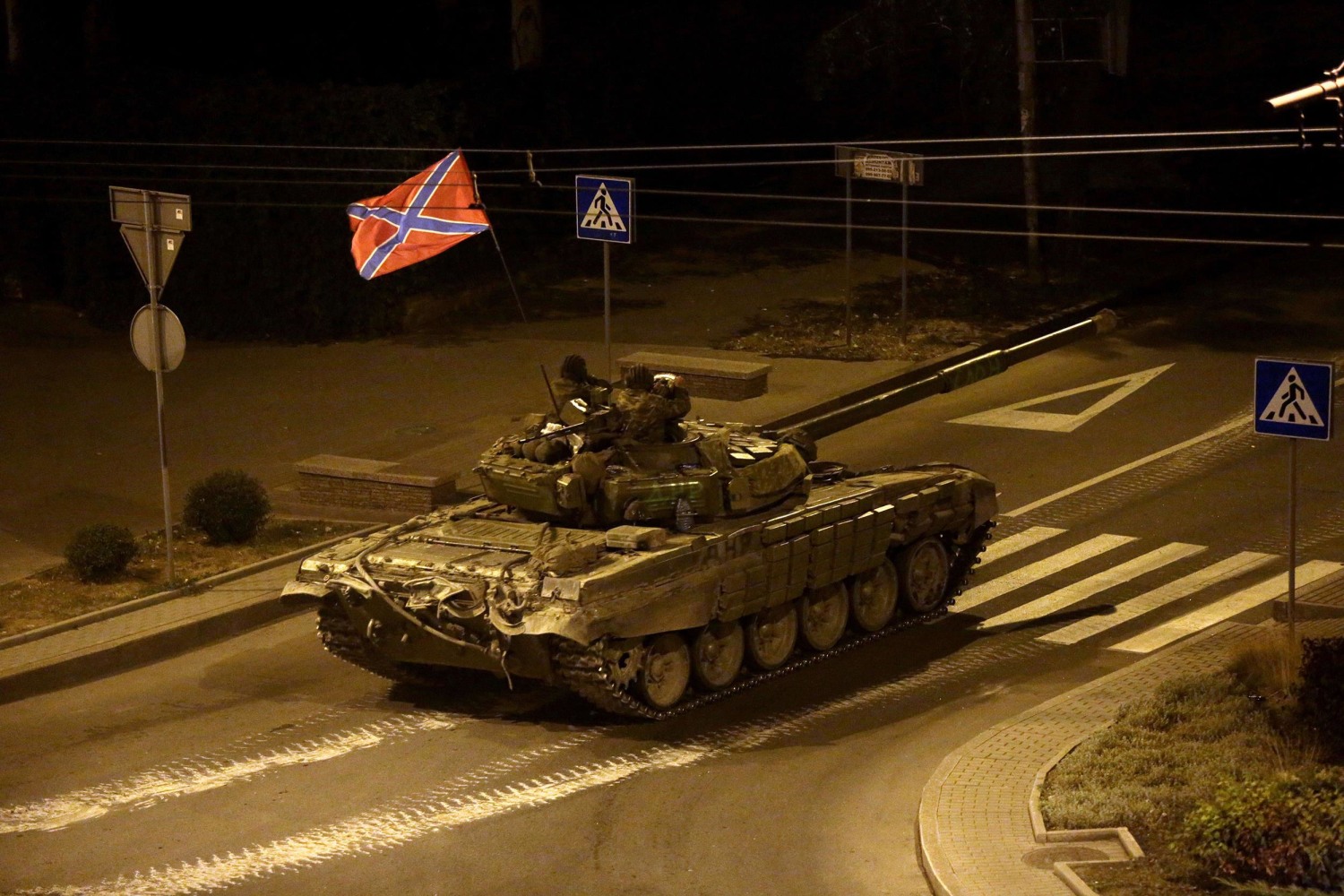 A tank of the United Armed Forces of Novorossiya, the separatist forces in the war in Donbas of the unrecognized pro-Russian breakaway regions in Ukraine called the Donetsk People's Republic and Luhansk People's RepublicUkrainian counter-offensive A tank of the United Armed Forces of Novorossiya, the separatist forces in the war in Donbas of the unrecognized pro-Russian breakaway regions in Ukraine called the Donetsk People's Republic and Luhansk People's RepublicUkrainian counter-offensive A Ukrainian military convoy moves along a road near Donetsk on Saturday, August 19 2014. Ukraine said the same day it had headed off an attempt by Russia to send troops into Ukraine under the guise of peacekeepers with the aim of provoking a large-scale military conflict, a statement Moscow dismissed as a "fairy tale." Ukraine launched a military counter-offensive against pro-Russian forces in April 2014, called the "Anti-Terrorist Operation" (ATO) from 2014 until 2018, when it was renamed the "Joint Forces Operation" (JFO). By late August 2014 this operation was able to vastly shrink the territory under the control of the pro-Russian forces, and came close to regaining control of the Russo-Ukrainian border. In response, Russia abandoned its hybrid approach, and began a conventional invasion of the Donbas. Between 22 and 25 August 2014, Russian artillery, personnel, and what Russia called a "humanitarian convoy" crossed the Ukraine-Russia border. Crossings occurred both in areas under the control of pro-Russian forces and in areas that were not under their control, such as the south-eastern part of Donetsk Oblast, near Novoazovsk. These events followed the reported shelling of Ukrainian positions from the Russian side of the border over the course of the preceding month. Head of the Security Service of Ukraine, Valentyn Nalyvaichenko characterised the events of 22 August as a "direct invasion by Russia of Ukraine", while other Western and Ukrainian officials described the events as a "stealth invasion" of Ukraine by Russia. Russia's official position on the presence of Russian forces in Donbas has been vague: while official bodies have denied presence of "regular armed forces" in Ukraine, it has on numerous occasions confirmed presence of "military specialists", along with other euphemisms, usually accompanied by an argument that Russia "was forced" to deploy them to "defend the Russian-speaking population". A Ukrainian military convoy moves along a road near Donetsk on Saturday, August 19 2014. Ukraine said the same day it had headed off an attempt by Russia to send troops into Ukraine under the guise of peacekeepers with the aim of provoking a large-scale military conflict, a statement Moscow dismissed as a "fairy tale." Ukraine launched a military counter-offensive against pro-Russian forces in April 2014, called the "Anti-Terrorist Operation" (ATO) from 2014 until 2018, when it was renamed the "Joint Forces Operation" (JFO). By late August 2014 this operation was able to vastly shrink the territory under the control of the pro-Russian forces, and came close to regaining control of the Russo-Ukrainian border. In response, Russia abandoned its hybrid approach, and began a conventional invasion of the Donbas. Between 22 and 25 August 2014, Russian artillery, personnel, and what Russia called a "humanitarian convoy" crossed the Ukraine-Russia border. Crossings occurred both in areas under the control of pro-Russian forces and in areas that were not under their control, such as the south-eastern part of Donetsk Oblast, near Novoazovsk. These events followed the reported shelling of Ukrainian positions from the Russian side of the border over the course of the preceding month. Head of the Security Service of Ukraine, Valentyn Nalyvaichenko characterised the events of 22 August as a "direct invasion by Russia of Ukraine", while other Western and Ukrainian officials described the events as a "stealth invasion" of Ukraine by Russia. Russia's official position on the presence of Russian forces in Donbas has been vague: while official bodies have denied presence of "regular armed forces" in Ukraine, it has on numerous occasions confirmed presence of "military specialists", along with other euphemisms, usually accompanied by an argument that Russia "was forced" to deploy them to "defend the Russian-speaking population". Ukrainian tanks near Artemivsk, eastern Ukraine, early 2015, photo by Gleb Garanich, March 4, 2015, ReutersAs a result of the invasion, DPR (Donetsk People's Republic) and LPR (Luhansk People's Republic) insurgents regained much of the territory they had lost during the Ukrainian government's preceding military offensive. Ukraine, Russia, the DPR and the LPR signed an agreement to establish a ceasefire, called the Minsk Protocol, on 5 September 2014. Violations of the ceasefire on both sides became common. Amidst the solidification of the line between insurgent and government-controlled territory during the ceasefire, warlords took control of swaths of land on the insurgent side, leading to further destabilisation. The ceasefire completely collapsed in January 2015, with renewed heavy fighting across the conflict zone, including at Donetsk International Airport and at Debaltseve. Involved parties agreed to a new ceasefire, called Minsk II, on 12 February 2015. Immediately following the signing of the agreement, separatist forces launched an offensive on Debaltseve and forced Ukrainian forces to withdraw from it. In the months after the fall of Debaltseve, minor skirmishes continued along the line of contact, but no territorial changes occurred. This state of stalemate led to the war being labelled a "frozen conflict"; despite this, the area remained a war zone, with dozens of soldiers and civilians killed each month. In 2017, on average one Ukrainian soldier died in combat every three days, with the number of Russian and separatist troops remaining in the region estimated at 6,000 and 40,000 respectively. By the end of 2017, the OSCE (the Organization for Security and Co-operation in Europe) observatory mission had accounted for around 30,000 individuals in military-style dress crossing from Russia to Donbas at the two border checkpoints it was allowed to monitor. The OSCE has also documented numerous cases of military convoys crossing from the Russian Federation into the occupied territory on dirt roads away from official border crossings and usually at night. Ukrainian tanks near Artemivsk, eastern Ukraine, early 2015, photo by Gleb Garanich, March 4, 2015, ReutersAs a result of the invasion, DPR (Donetsk People's Republic) and LPR (Luhansk People's Republic) insurgents regained much of the territory they had lost during the Ukrainian government's preceding military offensive. Ukraine, Russia, the DPR and the LPR signed an agreement to establish a ceasefire, called the Minsk Protocol, on 5 September 2014. Violations of the ceasefire on both sides became common. Amidst the solidification of the line between insurgent and government-controlled territory during the ceasefire, warlords took control of swaths of land on the insurgent side, leading to further destabilisation. The ceasefire completely collapsed in January 2015, with renewed heavy fighting across the conflict zone, including at Donetsk International Airport and at Debaltseve. Involved parties agreed to a new ceasefire, called Minsk II, on 12 February 2015. Immediately following the signing of the agreement, separatist forces launched an offensive on Debaltseve and forced Ukrainian forces to withdraw from it. In the months after the fall of Debaltseve, minor skirmishes continued along the line of contact, but no territorial changes occurred. This state of stalemate led to the war being labelled a "frozen conflict"; despite this, the area remained a war zone, with dozens of soldiers and civilians killed each month. In 2017, on average one Ukrainian soldier died in combat every three days, with the number of Russian and separatist troops remaining in the region estimated at 6,000 and 40,000 respectively. By the end of 2017, the OSCE (the Organization for Security and Co-operation in Europe) observatory mission had accounted for around 30,000 individuals in military-style dress crossing from Russia to Donbas at the two border checkpoints it was allowed to monitor. The OSCE has also documented numerous cases of military convoys crossing from the Russian Federation into the occupied territory on dirt roads away from official border crossings and usually at night.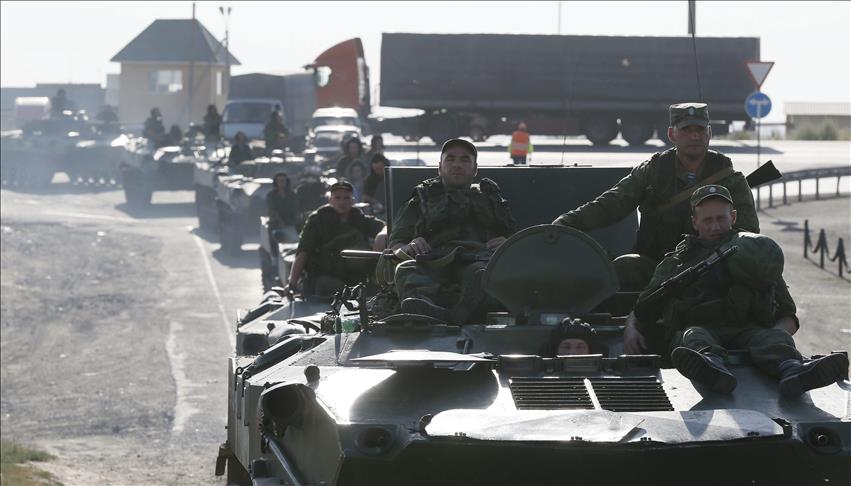 Russian military convoy enters Ukraine in 15.08.2014Since the start of the conflict there have been 29 ceasefires, each intended to remain in force indefinitely, but none of them have stopped the violence. The most successful attempt to halt the fighting was in 2016, when a ceasefire held for six consecutive weeks. The latest ceasefire (29th) came into force on 27 July 2020 which led to no Ukrainian combat losses for more than a month. According to Ukrainian authorities, from 27 July 2020 until 7 November 2020 Ukrainian mortal losses decreased tenfold (three Ukrainian soldiers were killed) and the number of attacks decreased 5.5-fold. Ukraine, Russia, the DPR, the LPR and the OSCE agreed to a roadmap for an end to the conflict on 1 October 2019. However, the conflict did not thaw since then and, by late summer 2020, still remained unresolved on multiple levels. The first trimester of 2021 saw a large increase in Ukrainian fatalities (25, compared with 50 deaths in the whole of 2020) and the build up of a large Russian military force on the Donbas-Russian border late March to early April 2021. Russian military convoy enters Ukraine in 15.08.2014Since the start of the conflict there have been 29 ceasefires, each intended to remain in force indefinitely, but none of them have stopped the violence. The most successful attempt to halt the fighting was in 2016, when a ceasefire held for six consecutive weeks. The latest ceasefire (29th) came into force on 27 July 2020 which led to no Ukrainian combat losses for more than a month. According to Ukrainian authorities, from 27 July 2020 until 7 November 2020 Ukrainian mortal losses decreased tenfold (three Ukrainian soldiers were killed) and the number of attacks decreased 5.5-fold. Ukraine, Russia, the DPR, the LPR and the OSCE agreed to a roadmap for an end to the conflict on 1 October 2019. However, the conflict did not thaw since then and, by late summer 2020, still remained unresolved on multiple levels. The first trimester of 2021 saw a large increase in Ukrainian fatalities (25, compared with 50 deaths in the whole of 2020) and the build up of a large Russian military force on the Donbas-Russian border late March to early April 2021.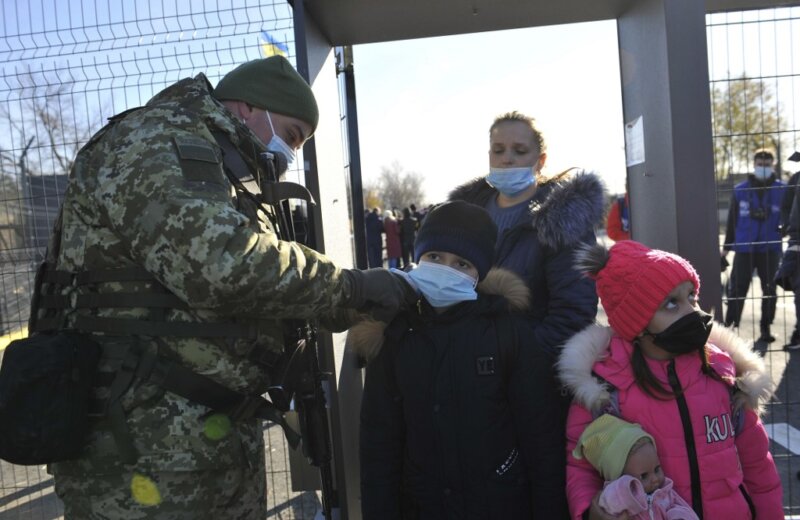 A Ukrainian border guard checks the temperature of a boy crossing the border at the checkpoint in the town of Schastya in Lugansk region on Nov. 10, 2020. A Ukrainian border guard checks the temperature of a boy crossing the border at the checkpoint in the town of Schastya in Lugansk region on Nov. 10, 2020.
|
|
|
|
Post by pieter on Dec 14, 2021 9:02:00 GMT -7
|
|
|
|
Post by pieter on Dec 14, 2021 9:14:41 GMT -7
2014
|
|
|
|
Post by pieter on Dec 14, 2021 11:05:55 GMT -7
This was not only taking part in 2014, but also in 2015, 2016, 2017, 2018, 2019, 2020 and 2021. It has war conditions like the Eastern Fronts of the First and Second World Wars. Trenches on both sides, tanks on both sides and tank battles. The Ukrainian army uses (Ukrainian T-84 tanks, T-80 Sovjet era tanks, T-72 Soviet/Russian main battle tanks, T-64 is a Soviet second-generation main battle tanks), BMP-3 is a Soviet and Russian infantry fighting vehicles, BMP-2’s, BMP-1‘a, BMD-2 Soviet airborne infantry fighting vehicles, Ukrainian build BTR-4 "Bucephalus" amphibious 8x8 wheeled armoured personnel carriers, BTR-3’s, BTR-80’s, BYR-70’s, BTR-60’s, Kozak-2’s (APC’s), KrAZ-5233 off-road trucks 4x4 for extreme operations, Canadian build STREIT Group Spartan armoured personnel carriers, Dozor-B four-wheeled Ukrainian armored cars, Ukraine build Novator light armored vehicles, American Humvee‘s, BRDM-2 amphibious armoured scout cars ( ("Combat Reconnaissance/Patrol Vehicles"), the Soviet era BRDM-1 "armored reconnaissance/patrol vehicle, the (British made) Saxon armoured personnel carriers, the BTR-D Soviet airborne multi-purpose tracked armoured personnel carriers, the Sovjet era PTS is a Soviet tracked amphibious transport vehicles, the MT-LB Soviet build multi-purpose fully amphibious auxiliary armored tracked vehicles. artillery, mortars, armored vehicles, Anti-Aircraft Air Defence systems, BUK M1 missiles, Mil Mi-24 attack helicopters, the Mil Mi-2, Mil Mi-8 and Mil Mi-26 transport helicopters, Bayraktar TB2 is a Turkish medium-altitude long-endurance (MALE) unmanned combat aerial vehicle (UCAV) capable of remotely controlled or autonomous flight operations, (Israeli build) IAI Bird-Eye Reconnaissance unmanned aerial vehicle‘s (UAV’s) and the (US build) AeroVironment RQ-11 Raven small hand-launched remote-controlled unmanned aerial vehicles(or SUAV’s), next to all the modern pistols, guns, automatic rifles, machine guns which are often the same as the ones of the Seperatists and their Russian backers. The Russian army and the United Armed Forces of Novorossiya (the separatist forces of the war in Donbas) and foreign militia on the side of the seperatists and Russia use the most modern Russian technology. So Russian tanks, armoured vehicle's, Air Defence, Drones, stack helicopters, drones, fighter yets and heavy bombers, Nuclear submarines and Navy ships and a lot of armed soldiers with rifles, pistols, machine guns and sniper rifles. Military industrial complex Ukraine: en.m.wikipedia.org/wiki/Defense_industry_of_Ukraine www.kmu.gov.ua/en/reformi/ekonomichne-zrostannya/military-industrial-complex-developmenten.m.wikipedia.org/wiki/T-84 |
|
|
|
Post by pieter on Dec 14, 2021 11:13:18 GMT -7
United Armed Forces of Novorossiya
2019 Donbas Region
|
|
|
|
Post by kaima on Dec 14, 2021 20:12:18 GMT -7
ichef.bbci.co.uk/news/976/mcs/media/images/76582000/jpg/_76582497_novorosnewafp.jpg It is estimated that more than 17,000 foreign fighters joined one of the armed parties in the conflict in Ukraine. That number is considerable, although it should be noted that the majority of these fighters – some 15,000 – came from Russia. The remaining group consists largely of 1,800 Europeans, of whom about a third joined the pro-Ukrainian groups, while the remaining two-thirds went to the separatists. According to the Soufan Center, this influx of foreign fighters should be seen in the context of the transnational rise of right-wing extremism (or white supremacy extremism, as the Soufan Center prefers to call it). This claim corresponds to a wider trend in the academic debate, with scholars increasingly shifting their attention away from jihadism towards such an alleged extreme-right wing wave of terrorism. The concern of the Soufan Center is that similar to how Afghanistan became a rallying point for jihadist groups in the 1980s, Ukraine has now become one for right-wing extremists, who are being hardened there both ideologically and militarily. As MacKenzie and Kaunert recently noted, such claims of the country being a “battlefield laboratory” are gaining prominence. Therefore, it seems high time to get a better.Pro-Russian activists in Eastern Ukraine (Donbas region) claimed: "Those people in Kyiv are Bandera-following Nazi collaborators." It is estimated that more than 17,000 foreign fighters joined one of the armed parties in the conflict in Ukraine. That number is considerable, although it should be noted that the majority of these fighters – some 15,000 – came from Russia. The remaining group consists largely of 1,800 Europeans, of whom about a third joined the pro-Ukrainian groups, while the remaining two-thirds went to the separatists. According to the Soufan Center, this influx of foreign fighters should be seen in the context of the transnational rise of right-wing extremism (or white supremacy extremism, as the Soufan Center prefers to call it). This claim corresponds to a wider trend in the academic debate, with scholars increasingly shifting their attention away from jihadism towards such an alleged extreme-right wing wave of terrorism. The concern of the Soufan Center is that similar to how Afghanistan became a rallying point for jihadist groups in the 1980s, Ukraine has now become one for right-wing extremists, who are being hardened there both ideologically and militarily. As MacKenzie and Kaunert recently noted, such claims of the country being a “battlefield laboratory” are gaining prominence. Therefore, it seems high time to get a better.Pro-Russian activists in Eastern Ukraine (Donbas region) claimed: "Those people in Kyiv are Bandera-following Nazi collaborators."] See a similarity in the flags as well as Russian support? .... and they move into the Capitol building to check out their new real estate. 
|
|
|
|
Post by pieter on Dec 15, 2021 3:01:31 GMT -7
Striking comparison Kaima. Fact is that both sides attract far right extremists and mercenaries. Poles fighting on both sides and also Russians fighting on both sides. Russian volunteers fight in the Azov Batallion against ethnic Russian seperatists and the Russian army. Also Dutch, South-African, American, Swedish, British, German, French, Croat and Serb mercenaries and volunteers fight on both sides. The Croats (Ustaše) on the Ukrainian side and the Serbs (Chetniks) on the Donbas and Luhansk Peoples Republics and Russian side. en.m.wikipedia.org/wiki/Usta%C5%A1een.m.wikipedia.org/wiki/Chetniks |
|
|
|
Post by Jaga on Dec 16, 2021 5:20:48 GMT -7
Pieter, I just saw the program about people living in the buffer zone. This are mainly elderly women and men who speak even partly Polish or Ukrainian that has some Polish words. They suffer from isolation and inability of not have a community anymore. This was not only taking part in 2014, but also in 2015, 2016, 2017, 2018, 2019, 2020 and 2021. It has war conditions like the Eastern Fronts of the First and Second World Wars. Trenches on both sides, tanks on both sides and tank battles. The Ukrainian army uses (Ukrainian T-84 tanks, T-80 Sovjet era tanks, T-72 Soviet/Russian main battle tanks, T-64 is a Soviet second-generation main battle tanks), BMP-3 is a Soviet and Russian infantry fighting vehicles, BMP-2’s, BMP-1‘a, BMD-2 Soviet airborne infantry fighting vehicles, Ukrainian build BTR-4 "Bucephalus" amphibious 8x8 wheeled armoured personnel carriers, BTR-3’s, BTR-80’s, BYR-70’s, BTR-60’s, Kozak-2’s (APC’s), KrAZ-5233 off-road trucks 4x4 for extreme operations, Canadian build STREIT Group Spartan armoured personnel carriers, Dozor-B four-wheeled Ukrainian armored cars, Ukraine build Novator light armored vehicles, American Humvee‘s, BRDM-2 amphibious armoured scout cars ( ("Combat Reconnaissance/Patrol Vehicles"), the Soviet era BRDM-1 "armored reconnaissance/patrol vehicle, the (British made) Saxon armoured personnel carriers, the BTR-D Soviet airborne multi-purpose tracked armoured personnel carriers, the Sovjet era PTS is a Soviet tracked amphibious transport vehicles, the MT-LB Soviet build multi-purpose fully amphibious auxiliary armored tracked vehicles. artillery, mortars, armored vehicles, Anti-Aircraft Air Defence systems, BUK M1 missiles, Mil Mi-24 attack helicopters, the Mil Mi-2, Mil Mi-8 and Mil Mi-26 transport helicopters, Bayraktar TB2 is a Turkish medium-altitude long-endurance (MALE) unmanned combat aerial vehicle (UCAV) capable of remotely controlled or autonomous flight operations, (Israeli build) IAI Bird-Eye Reconnaissance unmanned aerial vehicle‘s (UAV’s) and the (US build) AeroVironment RQ-11 Raven small hand-launched remote-controlled unmanned aerial vehicles(or SUAV’s), next to all the modern pistols, guns, automatic rifles, machine guns which are often the same as the ones of the Seperatists and their Russian backers. The Russian army and the United Armed Forces of Novorossiya (the separatist forces of the war in Donbas) and foreign militia on the side of the seperatists and Russia use the most modern Russian technology. So Russian tanks, armoured vehicle's, Air Defence, Drones, stack helicopters, drones, fighter yets and heavy bombers, Nuclear submarines and Navy ships and a lot of armed soldiers with rifles, pistols, machine guns and sniper rifles. Military industrial complex Ukraine: en.m.wikipedia.org/wiki/Defense_industry_of_Ukraine www.kmu.gov.ua/en/reformi/ekonomichne-zrostannya/military-industrial-complex-developmenten.m.wikipedia.org/wiki/T-84 |
|
|
|
Post by karl on Dec 16, 2021 11:44:23 GMT -7
Pieter
Realizing of course as only an opinion, but, it appears in reality of this mess that never seems to let up, is a prime example of the inability of the Ukrainian Governments inability to handle its own affairs properly. With this, they {Ukrainian government} would very be very happy to drag both or either NATO or THE EU in to their mess.
Let us face it, there is a Ukraine or not, there may not be part or partial. Either split the country up in to two seporate states or go on with a forever war.
Karl
|
|






























